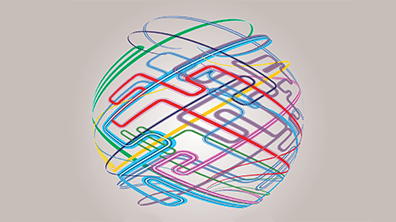Artificial intelligence (AI) can be categorised in various ways, including the hierarchical complexity level, learning methods and functionally. As AI becomes increasingly prevalent in accounting, audit and finance, it is crucial to comprehend the different types of AI, their learning capabilities and the diverse applications they offer.
This follow-up to our Understanding AI article provides an overview of the fundamental classifications of AI, beginning with the hierarchy of AI variants.
AI taxonomy by hierarchy
Artificial intelligence
AI is the broadest hierarchical category and encompasses techniques that enable machines to mimic human or other biological intelligence inferring from its input data and generating outputs without necessarily being explicitly coded to. AI is a broad field that can be further divided into subfields based on the goals, methods, or applications of the systems.
As mentioned in our previous article, one of the most widely accepted definitions of AI is currently the Organisation for Economic Co-operation and Development definition, which states: “An AI system is a machine-based system that, for explicit or implicit objectives, infers, from the input it receives, how to generate outputs such as predictions, content, recommendations, or decisions that can influence physical or virtual environments.”
Machine learning
Machine learning (ML) is a subset of AI that focuses on creating algorithms or systems that can learn from data and improve their performance without explicit programming. ML algorithms can be classified into supervised, unsupervised, or reinforcement learning depending on the type of training method and availability of feedback (explained later in this article). A simple use of an ML algorithm in accountancy could be identifying patterns and classifying accounts by type.
Deep learning
Deep learning (DL) is a subset of machine learning that uses artificial neural networks to model complex patterns and relationships in data. DL can handle various types of data, such as images, text, speech or video, and perform tasks such as classification, clustering or grouping data based on complex patterns, image recognition, forecasting or basic natural language processing, eg, translation.
The foundation of DL algorithms is a neural network (NN). Inspired by biological neural networks (e.g. the human brain), NNs learn to perform intricate pattern recognition tasks, such as image and speech recognition, which can, for example, empower a fraud analyst to identify fraudulent patterns through DL techniques. They are highly complex and usually the most capable AI algorithms. However, they are also resource intensive to train and run. An NN may be designed with several ‘deep’ layers of nodes processing information, hence the nomenclature ‘deep learning’.
Generative AI and GPTs
Generative AI (GenAI) is a subfield of deep learning characterised by the ‘generation’ of novel and realistic data or content based on highly complex learned relationships between data points in the training data. Generative pre-trained transformers (GPTs) are a family of large-scale models that can generate coherent and diverse natural language texts, images, audio and even videos based on a given prompt or context primarily based on an important ‘self-attention’ mechanism. GenAI models can use different techniques, such as variational autoencoders (VAEs), generative adversarial networks (GANs), or transformers, to generate new images, text, music or video content.
GenAI models that are pretrained on vast amounts of data and are adaptable for a wide range of tasks are commonly referred to as ‘foundation models’. They tend to be highly adaptable and can be ‘fine-tuned’ for more domain-specific use cases.
Large language models (LLMs) are a popular sub-category of GenAI models that are particularly trained on large corpus of text and, based on learned ‘embeddings’, can generate new text output based on text input. A good example of this would be the earlier versions of ChatGPT, such as ChatGPT 3.
Other examples of GenAI models can generate images from input text (eg, DALL-E, Midjourney, Stable Diffusion), video from input text (eg, Sora, Pika, Runway), text from input voice (eg, Whisper). A broader grouping of foundation models that can perform several of these text-to-text, text-to-image, voice-to-text, text-to-image, image-to-video, etc, functions in concert and process several different types of inputs are commonly referred to as ‘multimodal’ GenAI. The most recent version of ChatGPT – o1 – is a good example of a multimodal GenAI as it can perform several of these functions taking in different formats of input, eg, text, images and voice output in several formats as well.
AI taxonomy by technical (learning) methods
Supervised learning in AI is a technique that involves training a model with ‘labelled data’, meaning that each set of data inputs has an associated known outcome or target also fed into the model in training. The model learns to map the inputs to the outputs by minimising the error between its predictions and the actual targets. Supervised learning can be used for tasks such as classification, regression, or ranking.
Examples include decision trees, random forests, classification algorithms such as logistic regression and some NN applications
Unsupervised learning is a technique that involves training a model with ‘unlabelled data’, meaning that the inputs do not have any associated outputs or targets. The model learns to discover patterns, structures, or hidden variables in the data in an ‘unsupervised’ manner by optimising some objective function, such as clustering or dimensionality reduction. Unsupervised learning can be used for tasks such as customer segmentation, anomaly detection, data compression, or data augmentation.
Examples include clustering algorithms such as K-means, DBSCAN and Hierarchical.
Reinforcement learning (RL) is a learning technique in AI that involves training a model through feedback from the environment. The model learns to perform actions that maximise rewards or minimise penalties, guided by a reward function rather than predefined outputs. RL involves a balance between exploration (trying new actions) and exploitation (using actions that yield high rewards). It can be applied to tasks such as game playing, robotics and self-driving cars.
RL is a distinct type of machine learning that can sometimes use supervised learning techniques but is fundamentally different from both supervised and unsupervised learning. An important subset is reinforcement learning with human feedback (RLHF) where human reviewers are used to evaluate and score initial model outputs based on a predefined and common scoring system, eg, based on accuracy, precision, relevancy, model bias, etc. The model is then refined, fine-tuning based on the human feedback and giving a preferential ‘weighting’ to higher scoring initial outcomes using a reward system of positive and negative penalties for bad outcomes, thus improving the model over time.
This can be used to improve a fraud detection system over time, for example, or an AI-embedded accounting system used to automatically classify expenses.
AI taxonomy by function and process
AI can be divided into a third category based on functionality and process, such as forecasting and regression algorithms, classification, clustering or ‘grouping’, natural language processing (NLP), image recognition and computer vision (CV), recommendation systems, decision tree algorithms, and NNs. These categories may intertwine and overlap with the previously mentioned concepts, enhancing those categorisations and sometimes overlapping multiple areas.
Forecasting and regression algorithms: Forecasting algorithms are used to infer future numerical values using historical data, such as forecasting future sales or financial outcomes. This may, for instance, enable an accountant to anticipate a company’s cash flow by considering previous transactions and market factors. The broader use of regression algorithms may also be used to predict and interpolate missing values in a data set or series. Examples include linear regression, polynomial regression and ARIMA algorithms.
Classification is used for predicting and assigning predefined categorical labels to items. A potential use case could be enabling an auditor to classify risky and non-risky transactions based on set attributes and criteria.
Examples include decision trees, random forests and some applications of NNs.
Clustering groups items based on similarities or related features without preset labels, assisting a financial analyst in segmenting customers by spending habits, income, or preferences.
Examples include K-means, hierarchical clustering and DBSCAN algorithms.
Natural language processing (NLP) involves the processing of human language by AI, facilitating numerous tasks, such as sentiment analysis and machine translation. It is a very broad area of AI research with a plethora of applications. A use case could be enabling an auditor to automatically translate documents and reports from any language into their first language.
Image recognition and computer vision AI deal with interpreting visual information, from detecting faces to recognising text within images. This may be useful for invoice processing, fraud detection by pattern recognition, document verification (in KYC), stock/inventory management, and so on.
Recommendation systems provide user-centric suggestions tailored to individual behaviours and preferences, supporting a financial adviser in proposing suitable investment avenues to clients based on their risk tolerance and objectives.
This third taxonomy by functional application of the AI is non-exhaustive and it is worth noting that there are additional functional classes that may be included.
It is worth noting that these categories are not mutually exclusive. An AI model may be classified across all three taxonomies, eg, a machine learning model by hierarchical taxonomy, a supervised learning algorithm by learning method, and functionally, a classification algorithm as well as, eg, a random forest algorithm trained to predict account types.
As the use of AI becomes more and more pervasive, grasping the different AI types, whether classified by hierarchy (or complexity), learning methods, or function provides a solid foundational framework for newcomers, including accountants and finance professionals aiming to enhance their comprehension of artificial intelligence and ability to effectively audit and utilise AI embedded-systems and processes.
Paul Ekwere is Senior Manager – Data, Innovation and AI at BDO
Accounting Intelligence
This content forms part of ICAEW's suite of resources to support members in business and practice to build their understanding of AI, including opportunities and challenges it presents.



